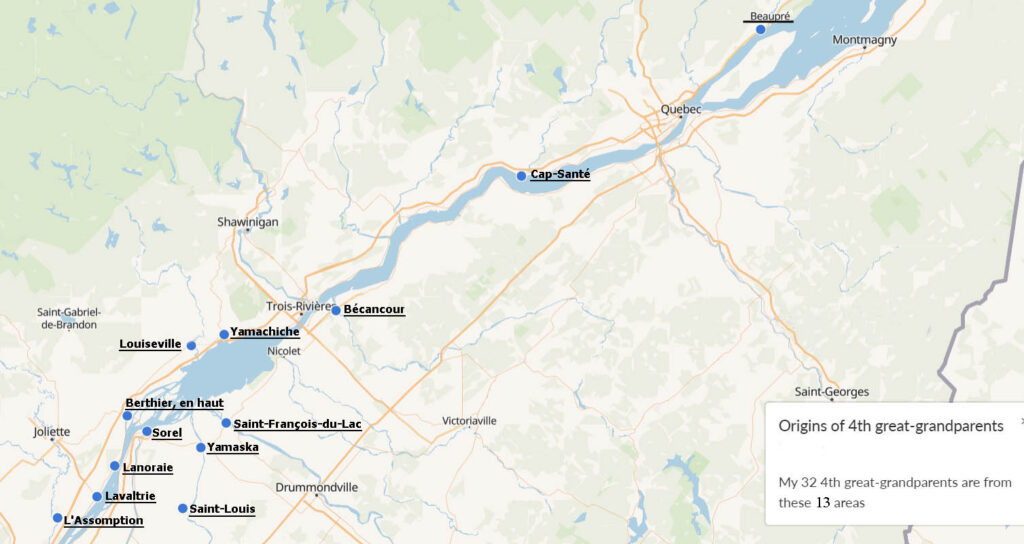My paternal 4th great-grandparents
I’ve listed and written about my 4 paternal great-grandparents, my 8 paternal great-great grandparents and my 16 paternal 3rd great grandparents, so let me introduce you to my 32 paternal 4th great-grandparents. I’ve grouped them using my great-grandparents as a reference.
These are William (Perry) Vadnais’ great-grandparents
Francois Vadnais, born February 10, 1767, Sorel, Richelieu, Quebec, Canada
Marie Genevieve Coulombe, born April 15, 1771, Berthier-en-Haut, Lanaudiere, Quebec, Canada
Joseph Petri Houde Houle, born September 3, 1767, Yamaska, Pierre-De Saurel, Quebec, Canada
Jeanne Loiseau Cardin, born February 23, 1774, Yamaska, Pierre-De Saurel, Quebec, Canada
Barthelemy Hus dit Lemoine, born August 17, 1766, Sorel, Richelieu, Quebec, Canada
Marie Ursule Blette, born May 26, 1769, Sorel, Richelieu, Quebec, Canada
Thomas Gautron Larochelle, born April 7, 1777, Sorel, Richelieu, Quebec, Canada
Marie Allard, born April 28, 1783, Sorel, Richelieu, Quebec, Canada
These are Jennie (Baillargeon) Vadnais’ great-grandparents
Antoine Baillargeon, born March 17, 1736, Sorel, Richelieu, Quebec, Canada
Marie Josephte Plouf (Plouffe), born March 13, 1751, Lanoraie, Lanaudiere, Quebec, Canada
Pierre Delisle, born November 25, 1749, Cap Sante, Portneuf, Quebec, Canada
Marie Therese Robert, born November 14, 1771, Louiseville, Maskinonge, Quebec, Canada
Joseph Giguere, born September 19, 1771, Sainte-Anne de Beaupre, La Cote-de-Beaupre, Quebec, Canada
Marie Josephe Gagnon, born April 4, 1776, Saint- Louis-de-L’Isle-aux-Coudres, Charlevoix, Quebec, Canada
Francois Laferriere, born December 15, 1772, Berthierville, Lanaudiere, Quebec, Canada
Marie Genevieve Jacques, born April 1782, Saint-Cuthbert, Lanaudiere, Quebec, Canada
These are Albert Peltier’s great-grandparents
Pierre Sulpice Pelletier, born July 7, 1757, Lavaltrie, D’Autray, Quebec, Canada
Marie Marguerite Cochu, born October 15, 1763, Lavaltrie, D’Autray, Quebec, Canada
Benjamin Perrault, born August 20, 1764, L’Assomption Lanaudiere, Quebec, Canada
Marie Francoise Dalpe Pariseau, born November 22, 1765, Yamachiche, Maskinonge, Quebec, Canada
Jean Baptiste Garceau, born February 17, 1774, Yamachiche, Maskinonge, Quebec, Canada
Marie Madeleine Rivard, born March 19, 1781, Yamachiche, Maskinonge, Quebec, Canada
Joseph Gingras, born January 19, 1776, Yamaska, Pierre-De Saurel, Quebec, Canada
Marguerite Beliveau, born May 30, 1774, Becancour, Centre-du-Quebec, Quebec, Canada
These are Celestine (Derosier) Peltier’s great-grandparents
Jean Baptiste Desrosier, born October 6, 1786, Yamaska, Pierre-De Saurel, Quebec, Canada
Marie Charlotte Pepin, born 15 November 1792, Yamaska, Pierre-De Saurel, Quebec, Canada
Jean Baptiste Cournoyer, born February 1784, Yamaska, Pierre-De Saurel, Quebec, Canada
Marie Luce Schmid, born November 7, 1891, Yamaska, Pierre-De Saurel, Quebec, Canada
Antoine Pelletier, born April 9, 1800, Yamaska, Pierre-De Saurel, Quebec, Canada
Adelaide Salva, born August 31, 1801, Yamaska, Pierre-De Saurel, Quebec, Canada
Joseph Deguire dit Desrosier, born November 1, 1802, Yamaska, Pierre-De Saurel, Quebec, Canada
Marie Rosalie Lienard dite Mondor, born January 27, 1802, St. Francois Du Lac, Nicolet-Yamaska, Quebec, Canada

Of these 13 locations, 11 of my 4th great-grandparents were baptized in Yamaska, 6 in Sorel, 2 in L’Assomption, 3 in Yamachiche, 3 in the Berthier, en haut area and 2 in Lavaltrie. Of the 8 other locations, only one 4th great-grandparent was baptized at each one.
Thanks for visiting, come back soon,
Cynthia
© 2023 Copyright by Cynthia Vadnais, All Rights Reserved
1 Digital image, maphub.net, (https://maphub.net/cynv/origins-of-4th-great-grandparents#preview : accessed 16 November 2023).
My paternal 4th great-grandparents Read More »
